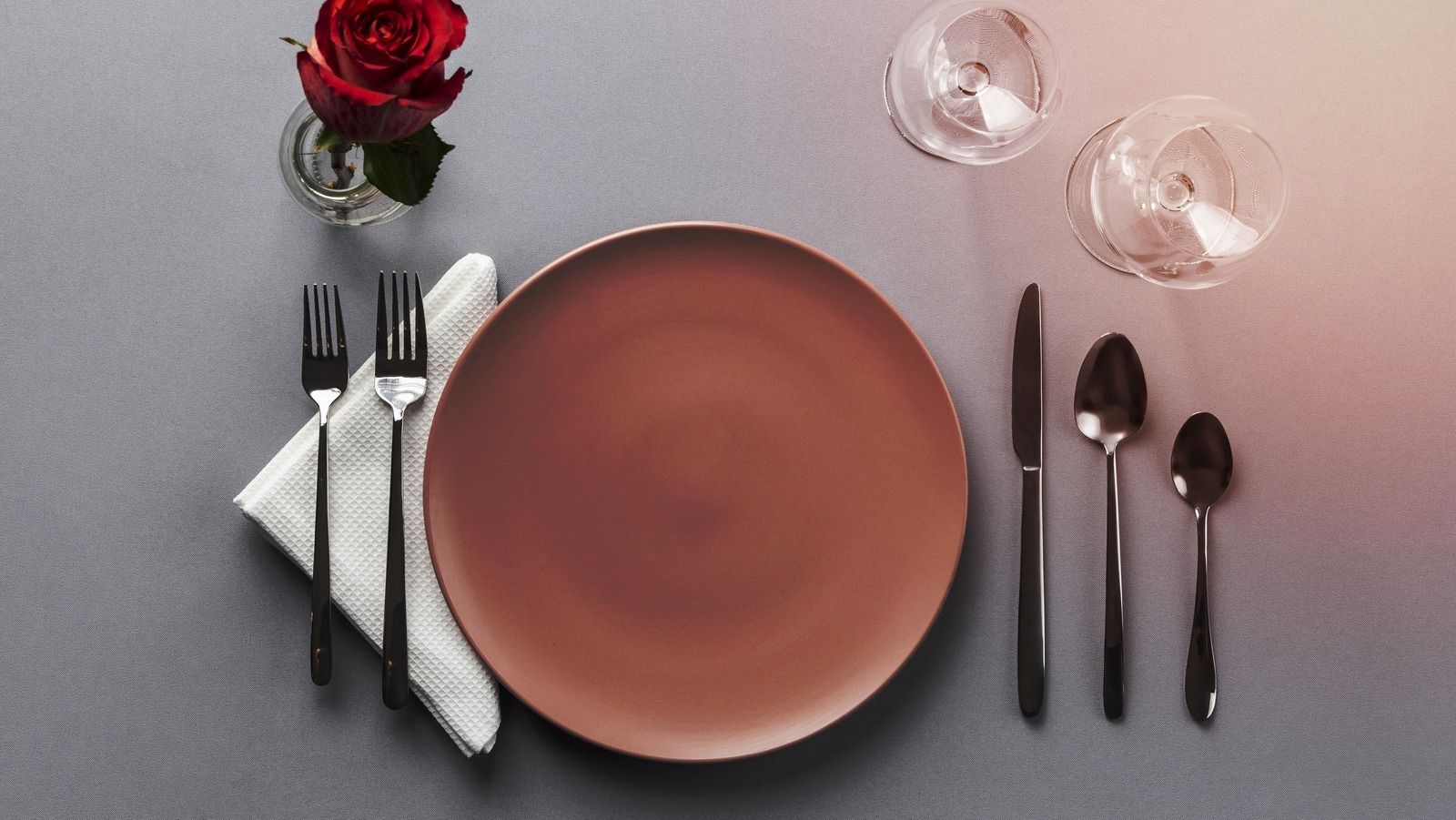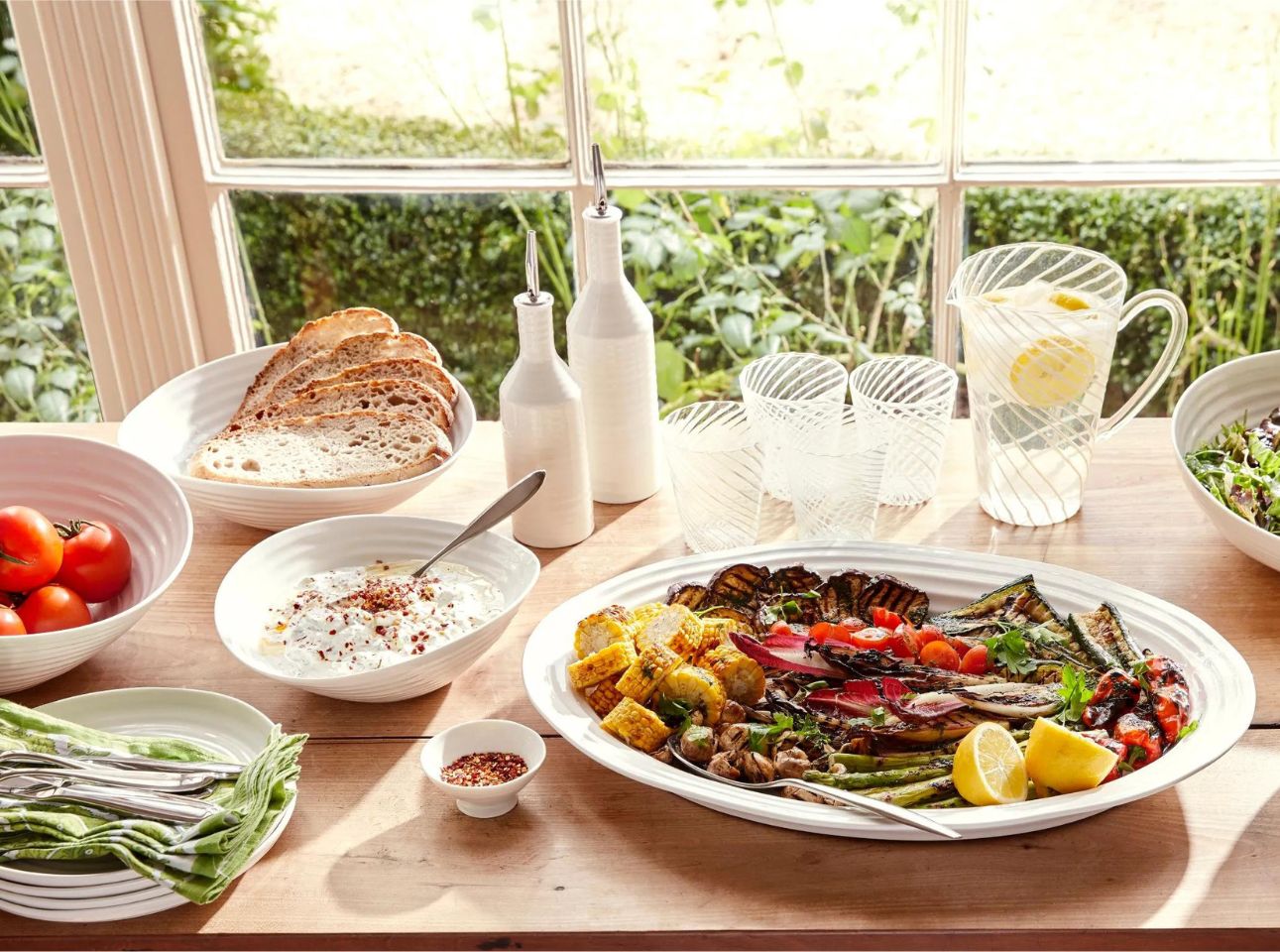Home>Dining>Tableware>How To Tell The Difference Between A Salad Fork And A Dinner Fork


Tableware
How To Tell The Difference Between A Salad Fork And A Dinner Fork
Modified: January 9, 2024
Learn how to distinguish between a salad fork and a dinner fork in our comprehensive guide to tableware essentials.
(Many of the links in this article redirect to a specific reviewed product. Your purchase of these products through affiliate links helps to generate commission for Storables.com, at no extra cost. Learn more)
Introduction
Tableware plays an essential role in our daily lives, especially when it comes to enjoying a delicious meal. Forks are a staple utensil in any dining setting, but did you know that there are different types of forks designed for specific purposes? In this article, we will explore the differences between a salad fork and a dinner fork to help you discern which is which.
Understanding the distinct features and purposes of these forks will not only enhance your table manners but also transform your dining experience. So, let’s dive in and unravel the mysteries of these two essential pieces of cutlery.
Before we dive into the physical differences, it’s important to understand what forks are and their primary function. Forks have been used for centuries as a tool for lifting and conveying food to the mouth. They consist of a handle and tines, which are the prongs that spear and hold the food.
Now that we have a basic understanding of forks, let’s examine the physical differences between a salad fork and a dinner fork.
Key Takeaways:
- Understanding the physical and visual differences between salad forks and dinner forks is crucial for proper table etiquette and an enhanced dining experience. Size, shape, and prong variation play a significant role in distinguishing between the two utensils.
- By selecting the appropriate fork for each course, you can confidently navigate the dining table and showcase proper etiquette. Whether enjoying a light salad or a hearty main course, choosing the right fork enhances the dining experience.
Understanding Forks
Forks are an essential part of tableware, and they come in various shapes, sizes, and designs. Each type of fork serves a specific purpose, depending on the dish being served or the course of the meal. A clear understanding of different forks will help you navigate the dining etiquette maze with ease.
When it comes to understanding forks, it’s important to note that the terms “salad fork” and “dinner fork” refer to specific types of forks commonly used for different occasions or courses during a meal.
Salad forks are typically smaller than dinner forks and are specifically designed for eating salad. They feature shorter and narrower tines compared to dinner forks, making them suitable for picking up leafy greens, vegetables, and other light ingredients without overpowering the delicate textures.
Dinner forks, on the other hand, are larger and have longer and broader tines. They are intended for general meal consumption, including the main course, side dishes, and other heartier food items. Dinner forks provide the necessary length and strength to handle heartier textures while ensuring efficient and comfortable eating.
Understanding the physical differences between salad forks and dinner forks is crucial in distinguishing one from the other. So, let’s delve deeper into the specifics of their physical characteristics.
Physical Differences
The physical differences between a salad fork and a dinner fork are evident in their various attributes, including size, shape, and prong variation.
Size and Shape Comparison:
A salad fork is generally smaller in size compared to a dinner fork. It is designed to be lighter and more delicate, with shorter overall length and narrower tines. This size difference allows for ease of use when eating lighter dishes such as salads and appetizers.
On the other hand, a dinner fork is larger and more substantial in size. It is characterized by longer overall length and broader tines. This larger size is suited for tackling heartier main courses and side dishes, providing the necessary strength and stability.
Prong Variation:
Another notable physical difference between salad forks and dinner forks lies in the prong variation. Salad forks typically have three tines, while dinner forks commonly have four. The additional prong on a dinner fork helps with gripping and lifting larger food portions, such as meat or pasta, ensuring a more efficient dining experience.
These physical differences in size, shape, and prong variation make it easier to identify whether a fork is intended for salad or dinner purposes. However, it’s important to note that these variations may slightly differ depending on the specific design and style of the cutlery set.
Now that we understand the physical differences, let’s explore the unique purposes of salad forks and dinner forks.
Size and Shape Comparison
One of the key physical differences between a salad fork and a dinner fork is their size and shape. These differences play a significant role in their respective purposes and functionality.
A salad fork is typically smaller in size compared to a dinner fork. It is designed to be lighter and more delicate, allowing for ease of use when enjoying salads, appetizers, and other lighter dishes. The overall length of a salad fork is usually shorter, making it comfortable to maneuver while eating. The tines of a salad fork are narrower and often slightly curved, allowing them to easily spear and lift small bites of salad without damaging the delicate leaves or ingredients.
On the other hand, a dinner fork is larger and more substantial in size. It is designed to handle heartier dishes such as main courses and side dishes. The longer overall length of a dinner fork provides the necessary reach and stability when enjoying larger portions of food. The tines of a dinner fork are broader and more sturdy, allowing them to effectively pierce and lift heavier food items like meat, pasta, or vegetables.
The size and shape differences between salad forks and dinner forks are not only functional but also aesthetic. The contrasting sizes and shapes add visual variety to a table setting, enhancing the overall presentation of a meal. Additionally, the variation in size and shape helps diners differentiate between forks intended for specific courses or dishes, allowing for a more organized and enjoyable dining experience.
While the size and shape comparisons serve as general guidelines, it’s important to note that variations may exist depending on the specific design and style of the cutlery set. However, in most cases, the size and shape differences are consistent enough to distinguish between a salad fork and a dinner fork.
Now that we’ve explored the size and shape comparisons, let’s dive deeper into the variation in prongs between salad forks and dinner forks.
Prong Variation
Another physical difference between a salad fork and a dinner fork lies in the variation of prongs, which are the tines that spear and lift the food.
A salad fork typically has three prongs, while a dinner fork commonly has four. This difference in prong variation serves a specific purpose for each type of fork.
The three-prong design of a salad fork offers a more delicate and precise approach to enjoying light dishes. The three prongs provide enough stability to spear and lift the food without causing damage or squishing delicate ingredients, such as lettuce, herbs, or fruit slices commonly found in salads. The spacing between the prongs allows for efficient gripping, ensuring that each bite of salad can be enjoyed with ease.
On the other hand, a dinner fork typically features four prongs, which offers increased stability and strength. The additional prong provides a more secure hold on heartier food items, such as meats, pasta, or vegetables. The four prongs evenly distribute the weight of the food, making it easier to lift and enjoy without the risk of the food slipping or falling off the fork.
The prong variation is a crucial aspect to consider when distinguishing between a salad fork and a dinner fork. By examining the number of prongs, you can easily identify which type of fork is meant for a specific course or dish.
It’s important to note that while the variation in prong counts is common, some cutlery sets may have additional prongs on both salad forks and dinner forks. However, the general rule of three prongs for a salad fork and four prongs for a dinner fork remains consistent in most conventional flatware sets.
Now that we’ve explored the physical differences, let’s move on to understanding the usage differences between salad forks and dinner forks.
The salad fork is typically smaller and has a more curved shape, while the dinner fork is larger and has straighter tines. Look for the smaller, more rounded fork for your salad.
Usage Differences
Salad forks and dinner forks serve different purposes and are used for specific occasions or courses during a meal. Understanding the usage differences between these two types of forks can help enhance your dining experience and etiquette.
Purpose of Salad Forks:
Salad forks are designed specifically for enjoying salads, appetizers, and other lighter dishes. These forks are ideal for delicately lifting and consuming leafy greens, vegetables, and other small ingredients commonly found in salads. The smaller size and narrow tines allow for precise handling of the delicate components without disrupting their presentation or texture. Salad forks are typically used in the early stages of a meal when salads or appetizers are served.
Purpose of Dinner Forks:
Dinner forks, also known as main course forks, are intended for consuming heartier dishes such as main courses, side dishes, and other substantial food items. These forks are larger and sturdier, designed to handle the weight and texture of meat, pasta, vegetables, and other substantial components of a meal. Dinner forks are commonly used during the main course or any course that involves heartier dishes.
Understanding the specific purposes of salad forks and dinner forks can help you navigate the dining table with ease. By using the appropriate fork for each course or dish, you not only showcase proper etiquette but also enhance your dining experience by using the utensil best suited for the food you are enjoying.
In addition, using the correct fork demonstrates your attention to detail and respect for the meal and the efforts put into its preparation. It is essential to choose the right utensil to ensure that you can enjoy your food comfortably and gracefully.
Now that we’ve explored the usage differences between salad forks and dinner forks, let’s discuss how you can visually differentiate between the two.
Purpose of Salad Forks
Salad forks are a specific type of fork designed for a specific culinary purpose. Their smaller size and unique features make them perfect for enjoying salads, appetizers, and other light dishes. Let’s delve into the purpose and advantages of using a salad fork.
1. Navigating Delicate Ingredients:
Salads often contain delicate ingredients like leafy greens, herbs, fruits, and vegetables. A salad fork’s smaller size and narrower tines allow for precise handling of these delicate components. This prevents excessive damage or crushing, ensuring the salad retains its fresh appearance and texture until it reaches your plate.
2. Portion Control:
Salad forks are typically smaller than dinner forks, encouraging controlled portions. The reduced size of the fork helps you take smaller bites and slower eating, allowing you to savor the flavors and enjoy the different ingredients in each bite. This can be particularly helpful when trying to maintain a balanced diet or manage portion sizes.
3. Salad Dressing Distribution:
Salad forks excel at evenly distributing dressing onto individual bites. With their slender tines, you can dip the fork into the dressing, ensuring each bite is perfectly coated without overwhelming the delicate flavors of the salad. This allows for optimal flavor balance and enhances the overall eating experience.
4. Multi-purpose Use:
In addition to salads, salad forks can also be used for enjoying appetizers and other light dishes. Their smaller size makes them versatile for a range of culinary delights, from sampling bite-sized hors d’oeuvres to gracefully enjoying delicate seafood starters.
Ultimately, the purpose of a salad fork is to enhance the experience of consuming light and delicate dishes. Its smaller size, narrower tines, and intricate design make it the perfect tool for navigating and savoring the diverse flavors and textures found in salads and appetizers.
Now that we’ve explored the purpose of salad forks, let’s move on to understanding the purpose of dinner forks.
Purpose of Dinner Forks
Dinner forks, also known as main course forks, are an essential utensil in any dining setting. Their larger size and sturdier construction make them ideal for enjoying heartier dishes, including main courses, side dishes, and other substantial food items. Let’s explore the purpose and advantages of using a dinner fork.
1. Handling Heavier Textures:
Dinner forks are designed to handle the weight and texture of heartier food items. Whether it’s a tender piece of steak, a forkful of pasta, or a scoop of roasted vegetables, the larger and sturdier construction of a dinner fork provides the necessary strength and stability to lift and enjoy these substantial components of a meal.
2. Efficient Eating Experience:
The broader and more robust tines of a dinner fork allow for efficient eating. With their ability to securely pierce through the food, dinner forks offer stability and control, ensuring that every bite reaches your mouth intact. Whether you’re enjoying a juicy cut of meat or a heaping forkful of mashed potatoes, a dinner fork provides the necessary grip and support for an enjoyable dining experience.
3. Versatility:
Dinner forks are not limited to just main courses. They can also be used for enjoying side dishes, such as rice, steamed vegetables, or casseroles, as well as any other substantial components of a meal. Their size and strength allow for a wide range of dining options, making them a versatile utensil in various culinary settings.
4. Complementing Table Settings:
In addition to their functional purposes, dinner forks also contribute to the overall aesthetic appeal of the dining table. Their elegant design and larger size add visual interest and balance to the table setting, complementing other cutlery and enhancing the overall presentation of the meal.
The purpose of a dinner fork is to handle heartier textures and provide a seamless eating experience when enjoying main courses and other substantial food items. Its larger size, broader tines, and sturdy construction make it the ideal utensil for tackling robust dishes, ensuring a satisfying and enjoyable dining experience.
With a clear understanding of the purpose and advantages of both salad forks and dinner forks, you can now confidently navigate the dining table and select the appropriate utensil for your meal.
Now that we’ve explored the purpose of dinner forks, let’s move on to discussing visual differentiation between salad forks and dinner forks.
Visual Differentiation
One of the key aspects of distinguishing between a salad fork and a dinner fork is visual differentiation. While size and prong variation offer physical cues, there are additional visual factors that can help identify the correct fork for your meal.
1. Utensil Size and Shape:
As mentioned earlier, salad forks are typically smaller in size compared to dinner forks. When looking at a set of forks, you can easily identify the salad fork by its smaller overall length and narrower tines. In contrast, dinner forks will appear larger and have broader tines. Paying attention to the size and shape of the utensils can be a helpful visual indicator.
2. Fork Design:
Fork designs can differ between salad forks and dinner forks. While this may vary depending on the specific cutlery set, it’s common to find subtle design differences between the two. Salad forks might feature a more intricate and delicate design, reflecting their intended use for lighter dishes. Dinner forks, on the other hand, tend to have a more robust and sturdy design, emphasizing their suitability for heartier meals.
3. Etchings or Engravings:
Some cutlery sets may incorporate etchings or engravings on the handles of the forks. These decorative elements can provide a visual clue to differentiate between salad forks and dinner forks. Pay attention to any embellishments or markings that might indicate the intended use of the fork.
4. Fork Placement:
During a formal dining setting, forks are often placed on the table in a specific order. Salad forks are typically positioned on the outer left side of the place setting, while dinner forks are placed closer to the main plate. Visualizing the placement of the forks can help you identify which fork to use for each course.
By considering these visual cues, you can confidently differentiate between salad forks and dinner forks. However, it’s important to note that visual differentiation can vary depending on the specific design and style of the cutlery set. Familiarizing yourself with the specific features and arrangement of your own cutlery will ensure accurate identification and usage.
With an understanding of the visual differences, purposes, and usage of salad forks and dinner forks, you are now equipped to navigate the dining table with confidence and grace.
Now, let’s conclude our exploration of the differences between salad forks and dinner forks.
Read more: Why Is There A Notch In A Salad Fork?
Conclusion
In conclusion, understanding the differences between a salad fork and a dinner fork is essential for proper table etiquette and an enhanced dining experience. The physical differences, such as size, shape, and prong variation, play a crucial role in distinguishing between the two utensils.
A salad fork is smaller in size, with narrower tines and three prongs. It is specifically designed for enjoying salads, appetizers, and other light dishes. The delicate design of the salad fork allows for precise handling of delicate ingredients and controlled portions.
In contrast, a dinner fork is larger and sturdier, with broader tines and four prongs. It is intended for consuming heartier dishes, including main courses and side dishes. The dinner fork provides the necessary strength and stability to handle robust food textures comfortably.
Visual differentiation is another key factor in identifying the correct fork for your meal. Paying attention to the size, shape, and design of the fork, as well as considering any etchings or engravings, can help you select the appropriate utensil.
By understanding the purpose and visual differences between salad forks and dinner forks, you can confidently navigate the dining table and showcase proper etiquette. Selecting the correct fork for each course ensures a seamless and enjoyable dining experience, allowing you to fully appreciate the flavors and textures of your meal.
So, whether you’re indulging in a refreshing salad or savoring a hearty main course, make sure to choose the right fork for the occasion. Bon appétit!
Frequently Asked Questions about How To Tell The Difference Between A Salad Fork And A Dinner Fork
Was this page helpful?
At Storables.com, we guarantee accurate and reliable information. Our content, validated by Expert Board Contributors, is crafted following stringent Editorial Policies. We're committed to providing you with well-researched, expert-backed insights for all your informational needs.














0 thoughts on “How To Tell The Difference Between A Salad Fork And A Dinner Fork”